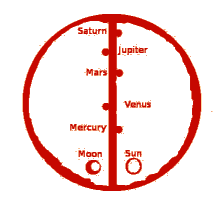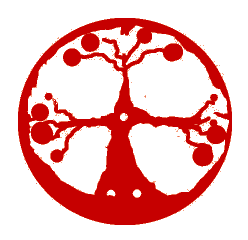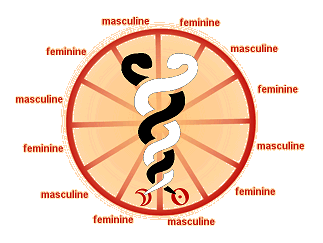The Astrology of Religion
Gender roles are extremely important to our religions. They all tell us what our sacred roles are in respect to our genders. In our patriarchal religions, men are exalted as the divine expression of sacred law, and women are admonished to be subservient to their men, to take care of his home and family for him. This is an unbalanced vision of gender roles, and needs to be changed.

Astrology and the structure of the zodiac indicate that religion and mythology are based on this astrological template, gaining its archetypal power to move us and to mythically explain the nature of our world in such a complete way.
The zodiac contains twelve signs placed within twelve houses. This circle is sectioned into quarters with power points facing the sacred four directions. These points are the Ascendant, the Midheaven, the Descendant, and the IC at the bottom of the circle. The most important and astrologically powerful of these points is the Ascendant. This is where the Sun rises each morning, bringing light and warmth to the world each new day.
In antiquity, the feminine sign Taurus, the Cow or the Bull, was placed on the Ascendant, ruler of the First House of the zodiac. Today we place the masculine sign Aries, the ram, as the natural ruler of the First House. Aries fits this position very nicely as far as astrological horoscope readings are concerned, but when we return to the Taurus zodiac something very magical happens. The zodiac reveals the hidden structure of religion, and the archetypal and equal astrological roots of gender roles.
Zodiac Structure
The twelve signs of the zodiac are ruled by the seven original planets in our solar system. These planets are in order of placement outward from the Sun. They are Mercury, Venus, Mars, Jupiter and Saturn, and the two lights, the Sun and Moon in their own placement within the zodiac. With Taurus on the Ascendant these ruling planets align in a vertical axis down the center of the zodiac. Starting at the top, the top two signs are Aquarius and Capricorn. Both of these signs are ruled by the planet Saturn. The Midheaven point sits between these two signs. Aquarius is a masculine sign and Capricorn is a feminine sign.
The next step down is ruled by the planet Jupiter. Jupiter rules the feminine sign Pisces below Aquarius on the left side of the circle, and the masculine sign Sagittarius below Capricorn on the right. Below Jupiter comes Mars, ruling the masculine sign Aries on the left and the feminine sign Scorpio on the right.
In the center of the zodiac sits the planet of love, Venus, ruling the feminine sign Taurus and the Ascendant on the left and the masculine sign Libra and the Descendant on the right. Then comes the fifth level down with the planet Mercury ruling the masculine sign Gemini on the left and the feminine sign Virgo on the right.
This point marks a shift in archetypal qualities. Each of the top five levels combines one masculine and one feminine sign under the rulership of one of the five original planets. There is a sacred gender balance at each level that descends from unity at the top. When this creative descent reaches the level of Mercury, division and multifaceted creation is embraced on an archetypal level, within the Mercury mind. Mercury rules division.
Below this position, division is made manifest with the two lights ruling one sign each, side-by-side in an equal balance to each other. The Moon rules the feminine sign Cancer on the left, and the Sun rules the masculine sign Leo on the right.
Here we have our divinely inspired gender roles. In this division, we can see the roots of gender separation and gender roles with the feminine gender role coming from the qualities of the feminine sign Cancer and the feminine Moon, and the masculine gender role arising from the masculine sign Leo and the masculine Sun. From this position we get our images of the Hero Twins of mythology, the Sun god Apollo, and his twin sister the Moon goddess Artemis. In Christianity, it is Adam and Eve.
Mythology

Axis Mundi. This simple structure within the zodiac reflects powerful mythological symbolism. The mythological image of the axis mundi is a universal image common in all mythologies. This is the axis around which the mundane world is created. This axis mundi comes from the zodiac and from this planetary axis around which the zodiac revolves. The zodiac is comprised of twelve animals or animating principles involved in the creation of life and the world. The ruling planet axis is the mythic axis mundi of the zodiac. The axis mundi is also known as the cosmic axis, the world axis, the world pillar, and the center of the world. This is the Greek Omphalos or navel of the world. It carries with it a feminine image of umbilical cord as well as a masculine image of erect phallus inseminating a uterus.

The World Mountain. The zodiacal axis mundi gives rise to another powerful universal mythological and religious image. This is the World Mountain, sacred to mythologies and religions around the world. Looking at the planet Saturn at the top of the axis, Saturn rules limitation and focus, as well as climbing to the highest levels of accomplishment. This implies the mythic quality of unity, where extraneous distractions are stripped away and a single minded focus implies the quality of pin point singularity. This gives us the image of the peak of a mountain.
Next comes Jupiter. Jupiter rules expansiveness against the singularity of Saturn. Unity is divided into two spheres, singularity and space. This is the first division in the process of creation. At the next level we have Mars, the planet of action and movement. This gives us another step in the process of creation. Movement within the silence of space adds dynamic activity to the stillness of space.
At the center of the creative process is Venus, the planet of love and desire. Venus adds yet another aspect of division, adding quality to movement. Here we have pleasant versus painful and other pairs of opposites based on the relative qualities inherent in various types of action and movement. Finally we have Mercury and the quality of division itself added to this creative process, of separating out from unity in order to create a template upon which the rest of creation can be set. The division of Mercury gives us a sudden and explosive multifaceted creation of life in all of its diversity on the archetypal level. At the bottom of this axis, the Moon and Sun separate from each other, give us the wide stance symbolic of the base of the World Mountain, Moon on the left and the Sun on the right.
Our Christian tradition holds Mt. Sinai as sacred, as well as the Temple Mount. The Black Hills are sacred to the Sioux Indians. Mt. Kailash is sacred in India, Mt. Kun Lun in China, and Mt. Fuji is sacred in Japan, and the list goes on. The monumental ancient Egyptian pyramids and Sumerian ziggurats were man made mountains mimicking the importance of the sacred mountain as centers of the universe.
The Sacred Tree. Another image of the axis mundi is the Sacred Tree. The central planet axis is the trunk of the tree, with its roots sunk deep into the soil of the Cancer/Leo gender balance. These planets, including the lights, rule the twelve signs. These planets reach out to guide the energies of the signs and in this reaching they are branches of creative energies. On these branches are the twelve fruit that mythically feed the nations. The Norse Yggdrasil is their sacred Ash. The Oak is sacred in the Americas, the Bodhi Tree sacred to Buddhists and this list goes on as well.
In our Judeo-Christian tradition we have the Tree of Life/Tree of Knowledge of Good and Evil. At this point I wish to change the term good and evil and replace it with Duality. This is a more accurate term without the judgmental gender baggage associated with it.
Creation Mythology
There are two basic categories of mythology; creation mythology and hero mythology. Creation mythology is described by descent along this astrological axis mundi. It proceeds from unity at the top to duality and the created universe at the bottom. This descent follows the direction of the Tree of Knowledge of Duality. Hero mythology describes the tribulations of ascent back up this tree to the heavenly state of Jupiter and Saturn at the top. The lessons of Saturn and the blessings of Jupiter are gained here before the hero returns to help his people.
Religion

Seven days of Creation. The Biblical account of creation, including the creation of man and woman, is an account of creation following the descent of creative energy down this astrological axis. The first story in the Book of Genesis is the Seven Days of Creation. These seven days correspond to the seven original ruling planets of the zodiac.
In Genesis, the First Day is that highest position. Let there be Light. God creates light to see by and act as a focal point for all creation. Creation is an active and therefore masculine process. The darkness gives birth to the light as that singular point from which all else can arise. Each subsequent day is a step lower along this creative stairway to earth. On the Second Day God creates a Jupiter “expanse”, a dome that he calls heaven. Heaven can be seen as silence or stillness, the bliss that comes with the vibration levels of that first light. This is Jupiter, expansiveness, and the creation of space around the single point.
The Third Day sees grasses and plants “shoot up” or sprout energetically and that are filled with vitality from the ground, and with the sexual seeds of their kind. This is the energetic expression of Mars and the life that Mars indicates. Our word violence comes from the root word for vitality, life. The impulse to life arises at this level.
The Fourth day sees the creation of stars and constellations of stars, (astrological constellations?) and the luminaries, the Sun and Moon. While this might place the Sun at this central position, there is something deeper in this. This is a relationship between Sun and Moon played out against the backdrop of the constellations, and reflects the relationship, love and creativity of Venus from an older matriarchal vision of life. Here we have quality of life, in twelve different areas, and the expression of desire within creation. Life has a reason to love itself, for there is much to choose from and to enjoy.
The Fifth Day gives rise to a “swarm” of life, birds of the air and monsters of the sea. Life is told, for the first time, to go forth and multiply. This reflects Mercury, and the explosion of the diversity of life at this level. This life, divided between air and sea, is that of archetypes, laws of nature, mathematical truths, ideas and emotions that express themselves as a huge pantheon of gods and goddesses.
At the bottom of this ladder, God created man and woman in his image. This creation of the human form, fully divided into female and male forms, took place on the Sixth Day, and on the Seventh Day God rested. Now, why is rest an important part of this creative process? Because it is astrological. The Sixth Day, the sixth step down from the top, falls at the level of Leo and the Sun. Leo is a creative fire sign ruling sex, through romance and affairs, and children. God created man and woman in his own image, sexual and passionate, on the Sixth Day preparing the world for love and relationship. And on the Seventh Day, at the level of the Cancer archetype of home, mothering, and nurturing, God came home to cease his work and to rest. As the Cancer mother carries new life within her womb, it can possibly be seen that God came to rest within the arms and the womb of the mother, and within the bodies of the man and woman created on the previous day. The final stage in this descent of creation is the creation of a divine state of relationship where desire and emotion can express themselves between these divine opposites, and enjoy themselves.

Garden of Eden. Creation, as it continues, is told in the story of the Garden of Eden. After the Seven Days, a Garden of Delights fills out around this axis. This Garden is the circle of the zodiac, walled in and protected by the sacred circle, containing every tree with fruit that is pleasing to look at and good to eat, to feed all of creation. These are the twelve astrological signs that describe, feed, and support all life. The animals that are pictured in this circle are symbolic of creative animating energies that feed us in so many ways.
Into this Garden, Adam, the red dirt man, is placed to till the soil. The soil is called Adamah, the feminine counterpart to Adam. In this image we have a picture of the womb, including the vulva, which is the cosmic Garden itself. Eden means “delight”, implying the inclusion of sensual and sexual pleasures into the delight of living. Adam is placed there to till the soil of her body. Adam then may be symbolic of the phallic, linear central axis ascending and descending, in and out, in and out, through the circular feminine soil and Garden of the Mother. This is the lingam (the sacrificial pillar, symbol of the God) that is the force of creation, sitting within the yoni, (the vagina, symbol of the Goddess) the source of creation in Hindu tradition.
As Adam and Eve, the mother of all life, leave the Garden behind, continuing the divine descent into creation and duality, they act as the vehicles for god, resting within them, to continue the process of creation. They take with them the qualities of Cancer and Leo, Moon and Sun, as their archetypal clothing. They are the mythological Hero Twins.
The Serpent

The Tree of Life/Tree of Knowledge of Duality in the center of the Garden, the phallic axis mundi, is home to the notorious serpent. The Serpent in this image is not an evil creature. The Serpent has two aspects. One is the image of the world encircling, tail eating serpent, Ouroboros. This is the circular serpentine image of the womb of the Mother, the powerful wisdom and life of the zodiac. In addition to the image of the serpent encircling the zodiac, the other image reveals the serpent standing erect on its tail as the most subtle and etheric central axis of the zodiac, a masculine phallic image. This erection is actually two serpents that are associated with the Tree of Life/Duality.
The twelve astrological signs alternate between feminine signs and masculine signs. By connecting all the feminine signs around the zodiac axis, starting with the sign Cancer at the bottom, and going to Capricorn at the top, the line zigzags back and forth across the zodiac, level by level, like a serpent. Following the same procedure for the masculine signs, beginning with Leo at the bottom, going to Aquarius at the top, we have another serpentine zigzag line that intertwines with the feminine serpent. This image is of two serpents, one feminine and one masculine, intertwined in relationship around a center pole or axis in an image known as the caduceus, our modern symbol for health.
This image is a double helix, indicating a powerful connection with life. This is also the Oriental image of the Ida and Pingala nerve channels spiraling around and surrounding the central nerves of the Shushumna, the spinal column within each of us.
Snakes mate while entwined around each other. The Serpent of the Garden, wrapped in sexual union, male and female, around the Tree of Knowledge, informs Eve that the fruit is ripe and that it is good to eat. After Adam and Eve eat this fruit and descend into Duality, they carry with them this serpent energy. This energy is now compressed, and lies on its belly on the earth of the Cancer archetypal center at the bottom of the zodiac. Cancer rules the land. This is the Kundalini serpent.
The masculine and feminine nature of our religious and mythological foundations adds mythic power to our positions as men and women in this world. As embodiments of the Hero Twins, we are co-creators with God of this world that we live in. Our relationships are designed to reflect that reality.

